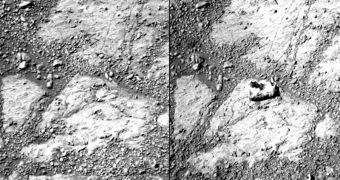Recent photographs collected by the Panoramic Camera (PanCam) instrument on the NASA Mars Exploration Rover (MER) Opportunity reveal a mysterious phenomenon occurring on the surface of our neighboring world. Images taken just days apart revealed a rock had popped out right in front of the robot.
Mission controllers at the NASA Jet Propulsion Laboratory (JPL), in Pasadena, California, were very surprised to see the stone emerging in views PanCam took on sol 3540, while pictures of the same area taken on sol 3528 revealed nothing. A sol is the scientific term for a Martian day.
What is even more interesting is the fact that JPL investigators have been handling Opportunity on the surface of Mars for nearly 10 years, and they have never seen anything like this happen before. The robot will celebrate its tenth anniversary on the Red Planet next Friday on January 24, 2014.
The appearance of the mysterious rock in the rover's field of view was announced by the lead scientist for the MER mission, Steve Squyers, who is based at the Cornell University. The fist-sized rock has since been named Pinnacle Island.
“It's about the size of a jelly donut. It was a total surprise, we were like 'wait a second, that wasn't there before, it can't be right. Oh my god! It wasn't there before!’ We were absolutely startled,” the expert said for Discovery News, as quoted by Space.
According to JPL experts, there are currently only two possible explanations for what happened, with the first centering on the rover. It is possible that Opportunity dislodged or flipped this rock from the ground as it was maneuvering between sols 3528 and 3540.
The only other explanation mission controllers were able to come up with to date is that a small fragment from an asteroid impacted the Martina surface just a few meters away from the rover. However, even the experts admit that this is the least-likely variant.
"So my best guess for this rock […] is that it's something that was nearby. I must stress that I’m guessing now, but I think it happened when the rover did a turn in place a meter or two from where this rock now lies,” Squyres said at a JPL event held on January 16 to mark 10 years of MER on Mar.

 14 DAY TRIAL //
14 DAY TRIAL //